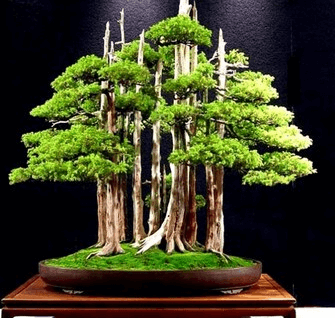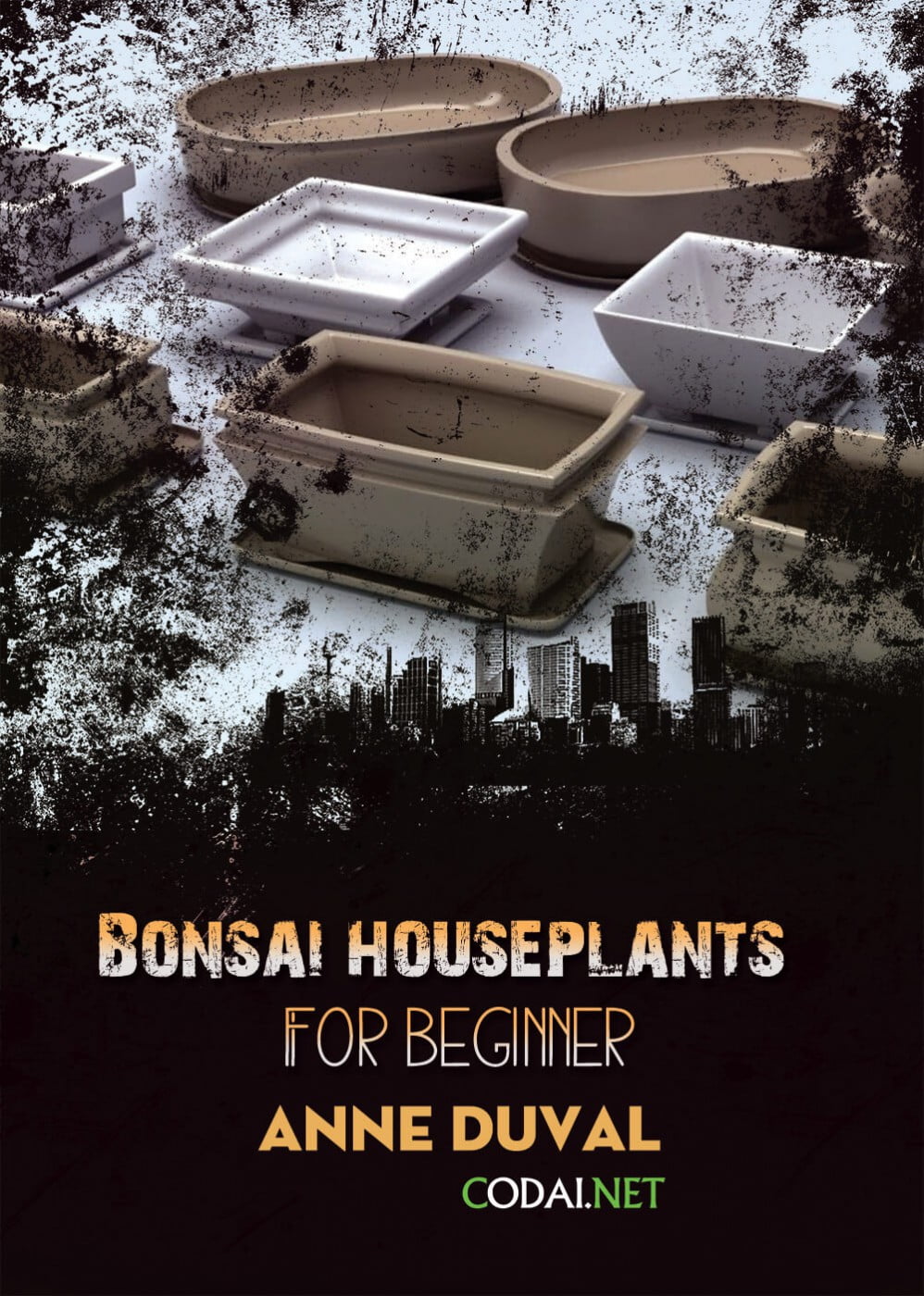[Ebook Việt Hoá] BONSAI and HOUSEPLANTS for Beginners - Anne Duval (Bonsai và Cây Cảnh trong nhà Houseplants cho người mới bắt đầu)
[Ebook Việt Hoá] BONSAI and HOUSEPLANTS for Beginners – Anne Duval – Bonsai Tree Pots (Chậu trồng Bonsai)
- Nguồn: [Ebook Việt Hoá] BONSAI and HOUSEPLANTS for Beginners – Anne Duval (Bonsai và Cây Cảnh trong nhà Houseplants cho người mới bắt đầu)
- Biên tập: Dũng Cá Xinh (Tháng 08/2021)
- Dịch: Huyền Nguyễn
English
In addition, most containers can serve as pots for the Bonsai tree if they meet certain requirements. Of example, drainage holes and wiring holes have to be created so that the tree can be connected to the plant. They may be made from ceramics, cement, plastics and certain materials (metals that emit toxins) and they may be manufactured from pots of their own. But what is called a typical Bonsai pot is that it is made of ceramic and porcelain and that it is burnt with stoneware, which ensures that it absorbs and does not hold any water in the material. It is important to the health of the trees.
Clear Advice On How To Pick A Pot
Case studies: Forest planting

Tiếng Việt
Cây là cây, chậu là chậu. Chưa thể gọi là cây Bonsai khi hai vật này chưa kết hợp lại với nhau và tạo thành một thể hoàn hảo. Một phần quan trọng của nghệ thuật Bonsai là việc cây được tách ra khỏi chậu.
Ngoài ra, hầu hết các thùng chứa đều có thể dùng làm chậu cho cây Bonsai nếu chúng đáp ứng các yêu cầu nhất định. Ví dụ, tạo các lỗ thoát nước và lỗ luồn dây để cố định cây vào chậu. Có thể làm chậu bằng gốm sứ, xi măng, nhựa và một số vật liệu nhất định ( trừ kim loại phát thải độc tố). Một chậu Bonsai điển hình là chậu được làm bằng gốm, sứ, được nung bằng chậu sành, đảm bảo không hấp thụ và giữ nước trong vật liệu. Điều quan trọng là sức khỏe của cây cối.
Sức khỏe của cây là trên hết! Một cây Bonsai hoàn chỉnh thường phải trải qua nhiều năm nuôi trồng và chăm sóc để hệ thống rễ thích nghi với các thùng chứa ngày càng nhỏ. Như bạn đã biết, trồng Bonsai là một quá trình đòi hỏi sự kiên nhẫn và kiên trì, điều này được thể hiện qua quá trình bạn tìm được một chiếc chậu ưng ý. Điều quan trọng nhất bạn cần lưu ý khi tìm chậu là các yêu cầu về đo lường, đặc biệt là độ sâu của chậu.
Lời khuyên về cách chọn chậu
Một vấn đề quan trọng trong quá trình trồng Bonsai là làm thế nào để tìm được một chiếc chậu phù hợp. Một số người chọn theo cảm giác. Nhưng điều đó sẽ khó với người mới … Vì vậy, dưới đây là một số quy tắc và hướng dẫn cơ bản để bạn tham khảo.
Chúc bạn may mắn và vui vẻ trong việc tìm kiếm ngôi nhà tương lai cho cây của mình.
Tính âm hay tính dương. Điều đầu tiên bạn cần làm là xác định xem cây của bạn là đực hay cái. Thông thường, cây có cả tính âm và tính dương, câu hỏi đặt ra là giới tính nào là trội nhất. Đây là vấn đề rất quan trọng và là nguyên tắc quan trọng nhất trong việc lựa chọn chậu cho cây. Một số đặc điểm như đường cong, sự uyển chuyển, vỏ cây bóng mượt và tán lá rải rác được coi là nữ tính. Các đặc điểm nam tính tương ứng là sức mạnh, vỏ cây già, gỗ chết, thân cây rậm rạp và cành nhỏ.
Chiều cao. Quy tắc chung là chậu phải có cùng chiều cao với thân cây tính từ rễ bề mặt. Chậu hình bầu dục hoặc hình chữ nhật thường có độ rộng bằng 2/3 độ rộng của cây. Chậu tròn hoặc vuông có độ rộng bằng 1/3 chiều rộng của cây – trừ khi tán lá to bất thường, thì chậu cũng sẽ to hơn, điều này được bù đắp bằng cách giảm chiều cao của chậu. Cây Phong tam giác (có rễ phát triển nhanh) cần các chậu có lòng sâu như chậu cho cây có hoa và cây ăn quả.
Thiết kế. Thiết kế chậu phải phù hợp với mức độ nam tính hay nữ tính của cây. Bạn càng đến gần, cảm nhận về cây Bonsai càng hài hòa. Để làm được điều này, cần xem xét dựa trên nhiều yếu tố. Nên chọn chậu lõm, lồi, tròn, vuông, bầu dục hay hình chữ nhật. Sau đó, để điều chỉnh mức độ nữ tính hoặc nam tính, bạn có thể có các lựa chọn về chi tiết, chân chậu, men và trang trí.
Nhìn chung chậu tính dương thường cao, vuông vắn, có đường nét thanh mảnh và chân chắc chắn. Đường viền ở miệng chậu làm tăng sự nam tính, đường viền bên trong làm tăng sự nữ tính của chậu. Những chậu tính âm thường có đường nét uyển chuyển, chân thon thì tương đối thấp và thanh thoát. Chậu vuông, tròn thường là những chậu mang cả tính âm và tính dương.
Nguyên tắc phổ biến nhất khi chọn men cho chậu là màu sắc phải làm nổi bật lá, màu gỗ, hình dáng của lá, quả hoặc hoa. Do đó, các tông màu không tráng men như nâu, xám và nâu đất thường là những lựa chọn an toàn. Những màu này mang đến năng lượng và sức mạnh cho cây. Nhưng chúng ta cũng có thể tìm các màu tương phản như xanh lam và vàng ấm. Chúng mang đến sự hài hòa và nét tươi mới.
Mục đích là tạo ra sự hài hòa. Quan sát cách người khác chọn chậu và thảo luận cùng họ. Tham dự các triển lãm, chương trình, đọc sách. Đừng ngần ngại liên hệ với thợ gốm. Cùng họ vẽ phác thảo hoặc đưa ra gợi ý về mẫu chậu phù hợp với cây của bạn. Lưu ý là, bạn không chỉ có một lựa chọn duy nhất trong việc chọn chậu phù hợp với cây. Bạn sẽ có nhiều lựa chọn tùy thuộc vào sở thích của mình, chính vì vậy bạn vui vẻ với lựa chọn của mình là điều quan trọng nhất.
Nếu bạn cảm thấy cây của mình đã ổn định, có một số cách tìm chậu cho cây. Bạn có thể liên hệ với thợ gốm hoặc đặt hàng theo yêu cầu. Ghé thăm vườn ươm Bonsai ở địa phương, hội chợ hoặc các bữa tiệc Bonsai, tại đây các thợ gốm cũng sẽ đến bán chậu. Hãy nhớ kĩ số đo của cây và hình ảnh. Nhưng nếu bạn đã dày dạn kinh nghiệm và biết mình phải tìm loại chậu nào thì bạn có thể lên các trang web đấu giá trên mạng và cộng đồng mua bán chậu bonsai. Bạn có cơ hội tự làm chậu không? Có rất nhiều video trên YouTube hướng dẫn cách làm chậu bằng các nguyên vật liệu khác nhau.
Kích thước tương đương với sức khỏe. Theo các quy tắc cơ bản, kích cỡ chậu không được rộng quá 2/3 chiều rộng của cây. Trong trường hợp này, chậu đã không tuân theo quy tắc vì vòm cây quá lớn, rộng gần bằng nó. Do đó, cần một chiếc chậu lớn không chỉ để đẹp và tạo sự hài hòa mà còn để các nhánh cây tương ứng với hệ thống rễ có không gian. Vì vậy, tán của cây phải rộng, rộng gần bằng đường kính của chậu. Thậm chí bạn còn nên chọn một chiếc chậu màu vàng để tôn lên màu đỏ của những chiếc lá mùa thu (dưới nền trắng).
Đây là ví dụ điển hình về sự kết hợp hoàn hảo của cây và chậu. Tổ hợp toát lên sự nam tính. Lá thưa thớt, vỏ dày sần sùi, kết hợp hoàn hảo với chậu có các đường mảnh, chân chậu chắc chắn. Các vân ở miệng chậu mở rộng tượng trưng cho sức mạnh tràn trề của tính dương. Ngược lại tính nữ sẽ có miệng cong vào trong. Có thể chọn loại đất nung đỏ không tráng men, thay vì một loại men đỏ có cùng tính năng. Với cây thông, chọn chậu có tông màu đỏ cam.
Tôi sẽ chọn loại chậu này nếu tôi trồng bonsai. Các cạnh được bo tròn hợp với phần rễ cong nhẹ tạo nên một cấu trúc duyên dáng và nữ tính hơn.
Đây là khi bỏ hết vành chậu, chân chậu to, vạm vỡ đã không còn nữa. Cá nhân tôi thấy đây là một sự kết hợp rất thú vị. Bạn có thể thấy, không giống như bức ảnh đầu tiên cây được trồng trong một chiếc chậu có hình dạng như một ngôi đền, giờ đây cây như đang ngự trị trên đỉnh một ngọn đồi. Tôi cảm giác rằng cái chậu hình túi này như đang bóp nghẹt cây. Nhưng ví dụ cho thấy cây thứ hai rõ ràng có nhiều tính nữ hơn những gì chúng ta nhìn thấy.
Ví dụ điển hình: Phong cách trồng rừng

Đây là tác phẩm huyền thoại trong giới Bonsai có tên là “Người bảo vệ linh hồn.” Nó có lịch sử lâu đời và đại diện cho hậu duệ của người sáng tạo. Cách lựa chọn chậu cho thấy những điều này. Thiết kế hình bầu dục được áp dụng với phong cách trồng rừng như thế này. Ở đây, lớp sơn đỏ của gỗ gợi nhớ đến đồ nội thất cổ, tạo cho cây vẻ đẹp xưa cũ. Bản thân chậu đã là một vật quý giá giúp nâng tuổi cũng như quyền năng cho cây mà không cần lấy đi bất cứ thứ gì của chúng. Với tác phẩm này, không có gì có thể thay thế được chiếc chậu hình bầu dục. Nhưng nó sẽ phù hợp với chậu có màu đỏ đất và không tráng men.



